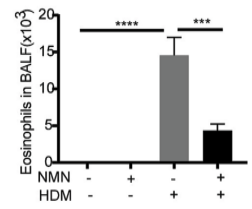In this study, researchers administered NMN via intraperitoneal (i.p.) injection to mice with induced asthma and analyzed its effects on lung function.
Key Points
- Reduced inflammation and mucus secretion in the lungs
- Suppressed the allergic response to house dust mites
- Restored the protective barrier of the lungs
- Demonstrated potential of i.p. NMN injection for treating allergic lung inflammation, as oral NMN delivery may perform differently
Study Evaluates the Effects of NMN in Asthmatic Mice
The researchers used the house dust mite (HDM)-induced asthma model in female mice for the study.
NMN was administered at a dose of 500 mg/kg, equivalent to approximately 40 mg/kg in humans. (1)
The mice were randomly divided into four groups:
- Control group = healthy mice, no treatment
- NMN group = healthy mice, received NMN (i.p., 500 mg/kg)
- HDM group = asthmatic mice, no treatment
- HDM + NMN group = asthmatic mice, received NMN (i.p., 500 mg/kg)
Asthma was induced in mice by exposure to HDM every day for 10 days. NMN was administered one hour before the HDM challenge.

Experimental design. Mice were sensitized to HDM via i.p. injection on days 0 and 7. For 10 consecutive days, mice were exposed to HDM intra-nasally to induce asthma. In treated mice, i.p. injections of NMN were administered one hour before HDM exposure. On day 18, the mice were sacrificed for analysis.
Reduced Airway Inflammation and Mucus Production
Treatment with NMN significantly suppressed asthma-induced inflammatory cell infiltration and increased mucus production in the lungs of the mice.

This figure shows that asthmatic mice (gray bar) had significantly elevated levels of eosinophils, (inflammatory immune cells) in their lungs. However, asthmatic mice treated with NMN (black bar) had significantly lower levels of eosinophils.
Treatment with NMN also decreased levels of the immune response marker for allergic reactions, Immunoglobulin E, in asthmatic mice.
“These results collectively suggest that NMN alleviates airway inflammation and reduces mucus secretion in HDM-induced asthmatic mice.”
Restored Lung Barrier Function
The barrier between the air and the inside of the lungs is often damaged in asthma.
Analysis revealed that NMN restored two proteins important for barrier function (E-cadherin and ß-catenin) in the airways of asthmatic mice.
“Treatment with NMN improved airway epithelial barrier disruption.”
Interestingly, inhibiting the protein SIRT3 blocked the protective effects of NMN. This finding suggests that NMN acts as a crucial player in the sirtuin pathway, a family of proteins known for their vital role in maintaining cellular health and longevity.
Demonstrated Potential of NMN Injection, as Oral NMN May Perform Differently
Scientists commonly use injections to directly introduce compounds into the bloodstream, avoiding the harsh conditions of the gastrointestinal (GI) tract.
This method tends to yield different results compared to oral delivery because the injected molecule is not susceptible to degradation during administration.
This study demonstrated the effectiveness of i.p. NMN injection (500 mg/kg) in alleviating airway inflammation in a model of asthma when administered one hour before an asthma challenge for ten consecutive days.
Conclusion
This study found that injection of NMN protected mice from asthma-induced inflammation, mucus production, and lung barrier disruption.
“We demonstrated that treatment with the NAD + precursor NMN can ameliorate allergic airway inflammation and HDM-induced epithelial barrier disruption.”
